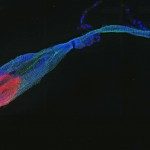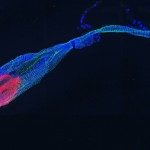Lien vers Pubmed [PMID] – 11087743
J. Biol. Chem. 2001 Mar;276(11):8288-96
The binding of chemokines to glycosaminoglycans is thought to play a crucial role in chemokine functions. It has recently been shown that stromal cell-derived factor-1alpha (SDF-1alpha), a CXC chemokine with potent anti-human immunodeficiency virus activity, binds to heparan sulfate through a typical consensus sequence for heparin recognition (BBXB, where B is a basic residue KHLK, amino acids 24-27). Calculation of the accessible surface, together with the electrostatic potential of the SDF-1alpha dimer, revealed that other amino acids (Arg-41 and Lys-43) are found in the same surface area and contribute to the creation of a positively charged crevice, located at the dimer interface. GRID calculations confirmed that this binding site will be the most energetically favored area for the interaction with sulfate groups. Site-directed mutagenesis and surface plasmon resonance-based binding assays were used to investigate the structural basis for SDF-1alpha binding to heparin. Among the residues clustered in this basic surface area, Lys-24 and Lys-27 have dominant roles and are essential for interaction with heparin. Amino acids Arg-41 and Lys-43 participate in the binding but are not strictly required for the interaction to take place. Direct binding assays and competition analysis with monoclonal antibodies also permitted us to show that the N-terminal residue (Lys-1), an amino acid critical for receptor activation, is involved in complex formation. Binding studies with selectively desulfated heparin, heparin oligosaccharides, and heparitinase-resistant heparan sulfate fragments showed that a minimum size of 12-14 monosaccharide units is required for efficient binding and that 2-O- and N-sulfate groups have a dominant role in the interaction. Finally, the heparin-binding site was identified on the crystal structure of SDF-1alpha, and a docking study was undertaken. During the energy minimization process, heparin lost its perfect ribbon shape and fitted the protein surface perfectly. In the model, Lys-1, Lys-24, Lys-27, and Arg-41 were found to have the major role in binding a polysaccharide fragment consisting of 13 monosaccharide units.

